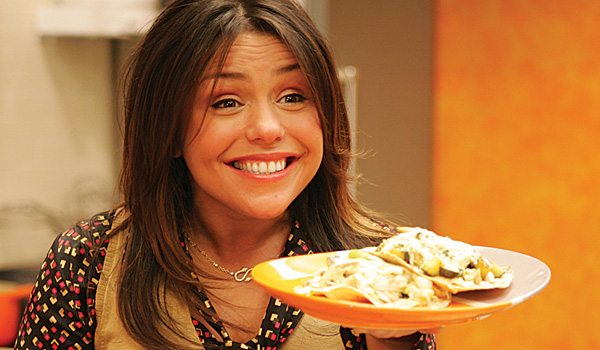What you can Learn from Rachel Ray, Julia Child, and Other Favorites
Except for my client Rebecca Joseph (aka The Rabbi Chef), your goal is probably not to be the Next Food Network Star.
But there’s a lot that celebrity chefs can teach us about working in a crowded marketplace. The successful ones truly excel at building their brands and growing their fan base.
How do they do it?
Here are five of their marketing strategies that you can (and should) adopt today:
1. Build a tribe of evangelists. Rohit Bhargava points out in, “5 Marketing Lessons from Jamie Oliver’s ‘Food Revolution‘,” that creating a solid group of supporters is key to the success of Oliver’s healthy food crusade. Here’s what Jamie does: he reaches out to people in the community ahead of time (before he begins a new campaign), and recruits leaders for his cause. He knows that influencers will speak on his behalf and help recruit others — making the process of marketing exponentially easier.
Lesson: Every community — online or off — has several people who stand out as leaders. Connect with them and get them on your side. Their help will be invaluable as you build and market your business.
2. Give people what they want. Jimmy Vee’s “Automotive Marketing Secrets from a Celebrity Chef” highlights several examples of how to do this. Take Emeril Lagasse. He loves to do book signings. Why? Because he gets to talk directly to hundreds of people who tell him what they want. Then all he has to do is give it to them.
Verne Ho points out that Gordon Ramsey is also an advocate for listening in “10 Things you can Learn from Gordon Ramsey about Running a Business.” One of the very first things he does (on his show, Kitchen Nightmares) when attempting to save a failing business is to go straight to the customers and hear the good, the bad, and the ugly. He goes out to the streets and asks the locals what they’ve heard, what their experience has been, and what would get them to go back to the restaurant in question.
Lesson: Listen to your prospects AND your customers. The web makes this process easy. Use web-based tools like Twitter, Facebook, email surveys and Google Alerts. Read and follow popular forums and communities relevant to your industry. Keep your eyes and ears open and you can learn all about your business, about your competition, and about your marketplace as a whole.
3. Be Memorable. Be Unique. Two of the Food Network’s biggest brands, Rachael Ray and Sandra Lee, both work in the same niche, yet still have a brand that sets them apart.
They’re both authorities in convenience: quick and easy, quality meal preparation for busy women (mostly). Yet each has carved out a distinct brand within that same space.
The foundation of Rachel Ray’s empire is her very emphatic tagline – “30 minute meals.” The name says it all. Sandra Lee’s tagline is “semi-homemade meals” — preparing meals with the aid of pre-packaged ingredients. They both sell essentially the same thing.
Leon Altman, in “A Branding Lesson from Rachel Ray and Sandra Lee,” points out that while both women have established authority within the convenience niche, their credentials don’t come from time spent as chefs or a formal culinary education. Their secret sauce is literally their unique personalities, presentation, and individual stories.
Lesson: Just because someone else is an authority in your niche, doesn’t mean you can’t create a different, yet successful brand within the same space. Leverage your back story, your personality, your hobbies or other unique qualities to make your brand stand out from the rest.
4. Share your recipes. Vanessa Pagan points out that “the difference between the famous chefs like Julia Child and Emeril Lagasse and their unknown and equally great counterparts is that the famous ones out-share, out-teach and out-contribute.” In her post, “Follow the Chefs: Marketing in a Crowded Industry,” Pagan explains that:
Famous chefs have cookbooks, cooking shows on local networks, cable channels or YouTube clips. Famous chefs teach regular people at home how to use the same recipes and make the same foods that they serve at their restaurants and in their homes. They passionately want their audience to follow along and create the same dishes because they are lifting the curtain on how to cook delicious foods and giving away their secrets and styles on cooking.
Giving away their methodologies hasn’t hurt their bottom lines. It’s actually helped build relationships between the chefs and their audience. Relationships that translate into enormous brand empires in the billions of dollars. Folks buy everything from prepared foods to cookware from their favorite celebrity chefs — not to mention visiting their restaurants in droves.
Lesson: Give away your best content. Formal marketing and advertising doesn’t work anymore. It’s time to teach and share.
5. Be Passionate! The one thing every celebrity chef has in common is that they don’t hold back when it comes to talking about their true love: food (eating it and cooking it). Take Julia Child for instance. If you’ve ever seen any of her old TV shows, you’ve seen first hand the joy she brought to every task — even one as mundane as de-boning a chicken!
And Emeril Lagasse, famous for “kicking it up a notch,” loves to pepper his explanations with a good healthy, “BAM!” Some celebrity chefs get so passionate they’ll let an F-bomb slip. Case in point: Gordon Ramsey, aka the F-Word Chef.
Lesson: Find a way to connect your deepest passion to your business. Remember Paul Cushing Child’s question to Julia, “What do you love to do?” Her answer: Eating! Your prospective customers can tell if you’re faking it. And they’ll stay away in droves.
What other marketing lessons have you learned from watching celebrity chefs? Share with us in a comment.











So many wonderful things to think about – thanks!
Thanks for sharing – already I feel your words and ideas are helping me better understand how to streamline my thoughts and hone my business…
I am not a follower of the chef’s but you have certainly done a fabulous job of giving us a great description of what they do and how well they market.. It is all about the marketing and for sure we can learn a great deal from them. Thanks for a great post!
Awesome stuff here! I never did climb aboard the food-show-fanatic train, but there are tons of great examples in marketing and branding. A lot of folks seem to have a hard time finding lessons in the big kids’ stories – as if there’s no comparison. But there SO is, as you’ve aptly demonstrated here!